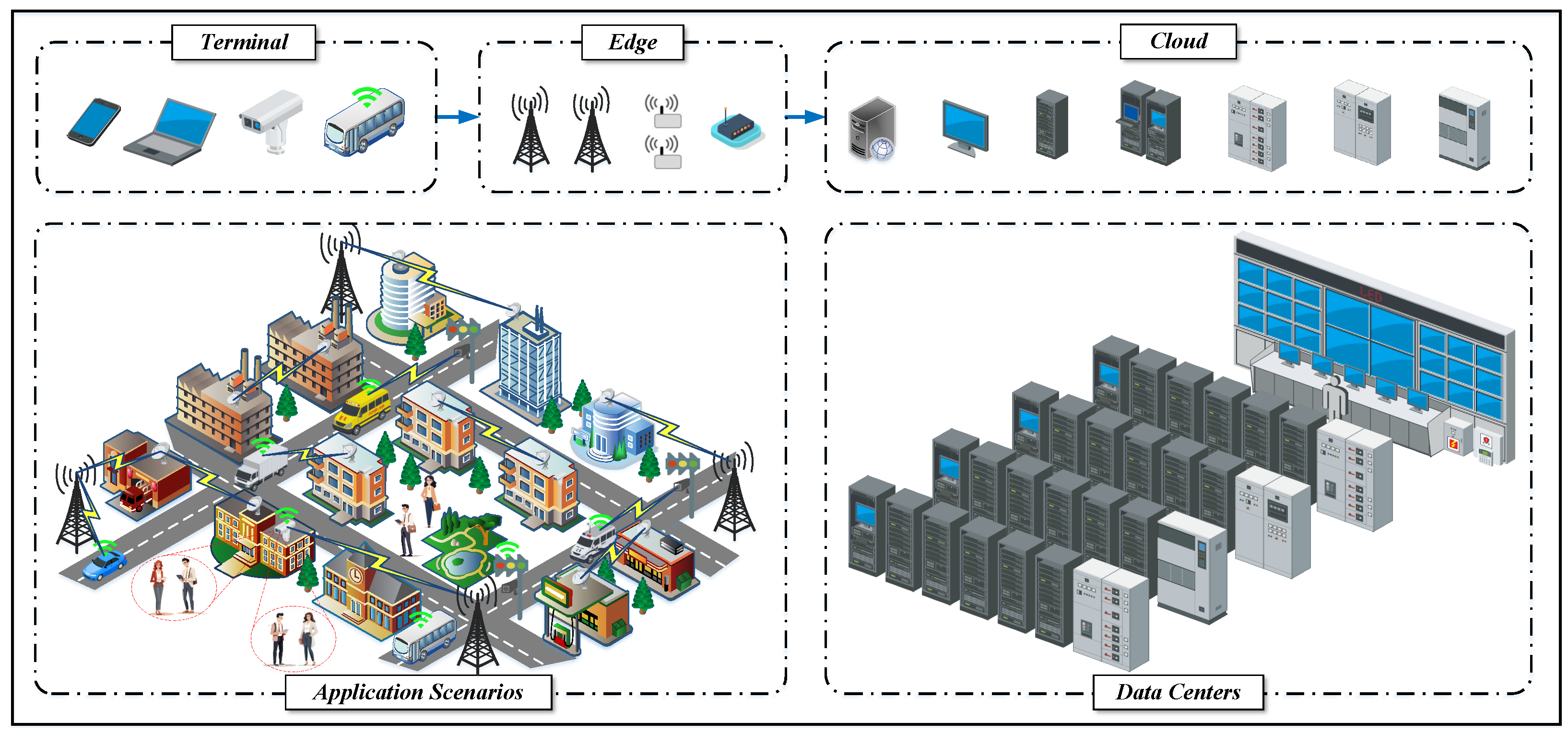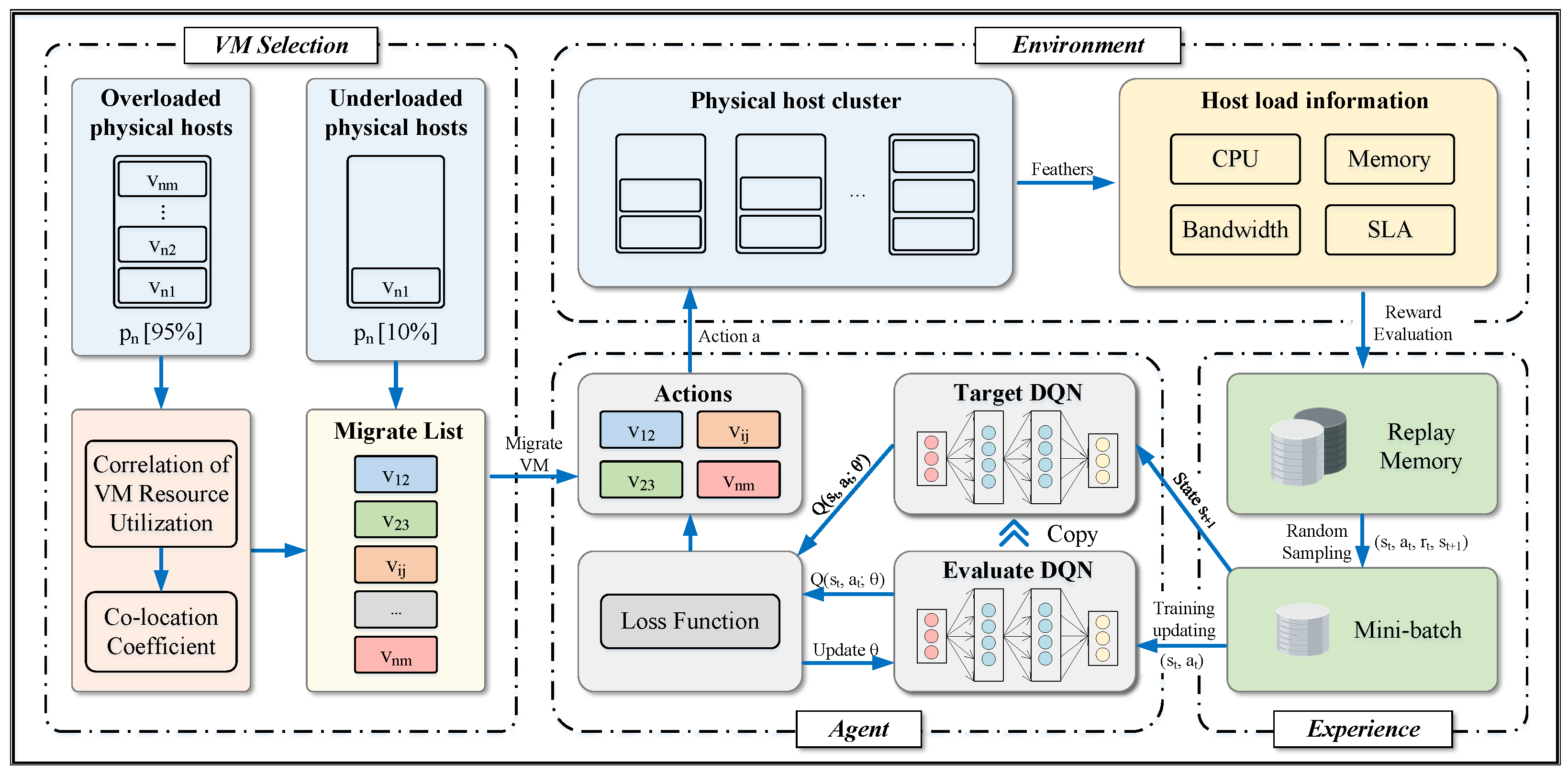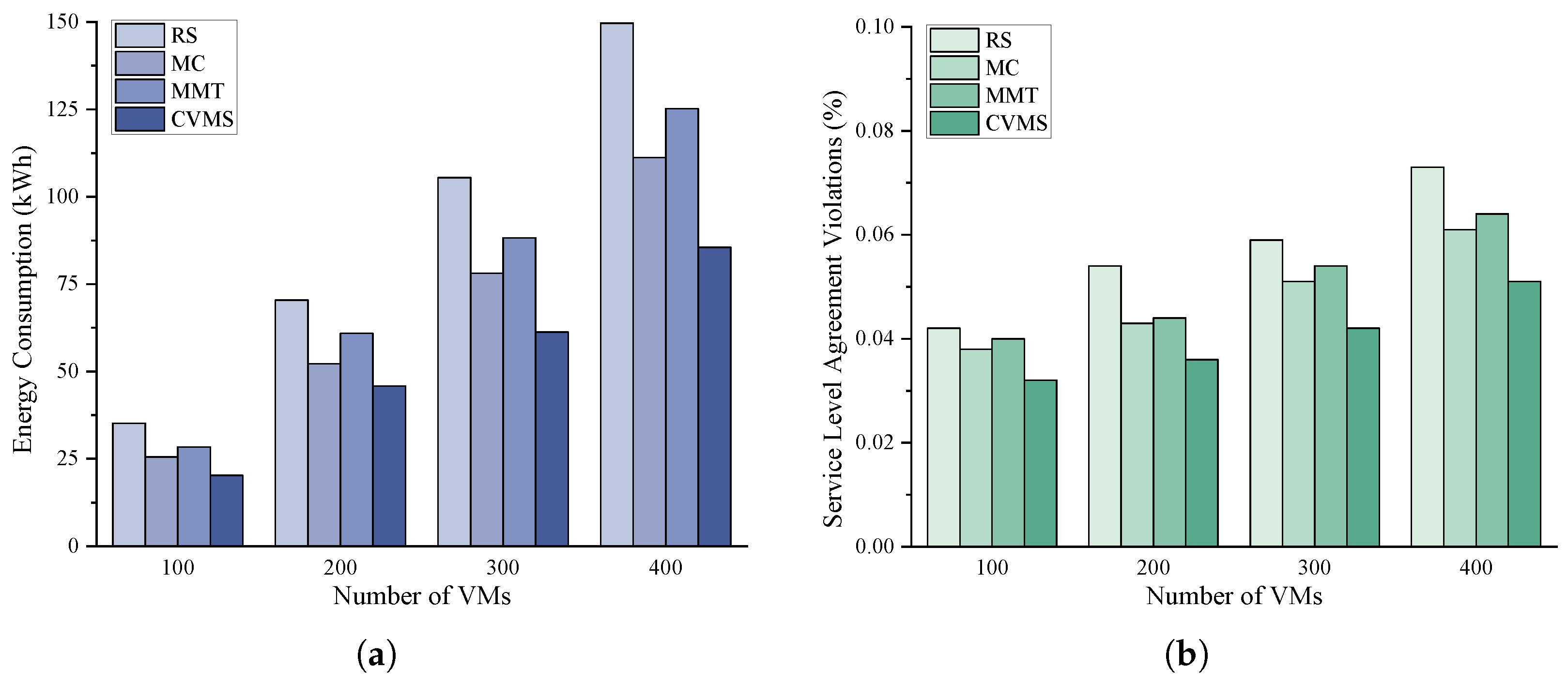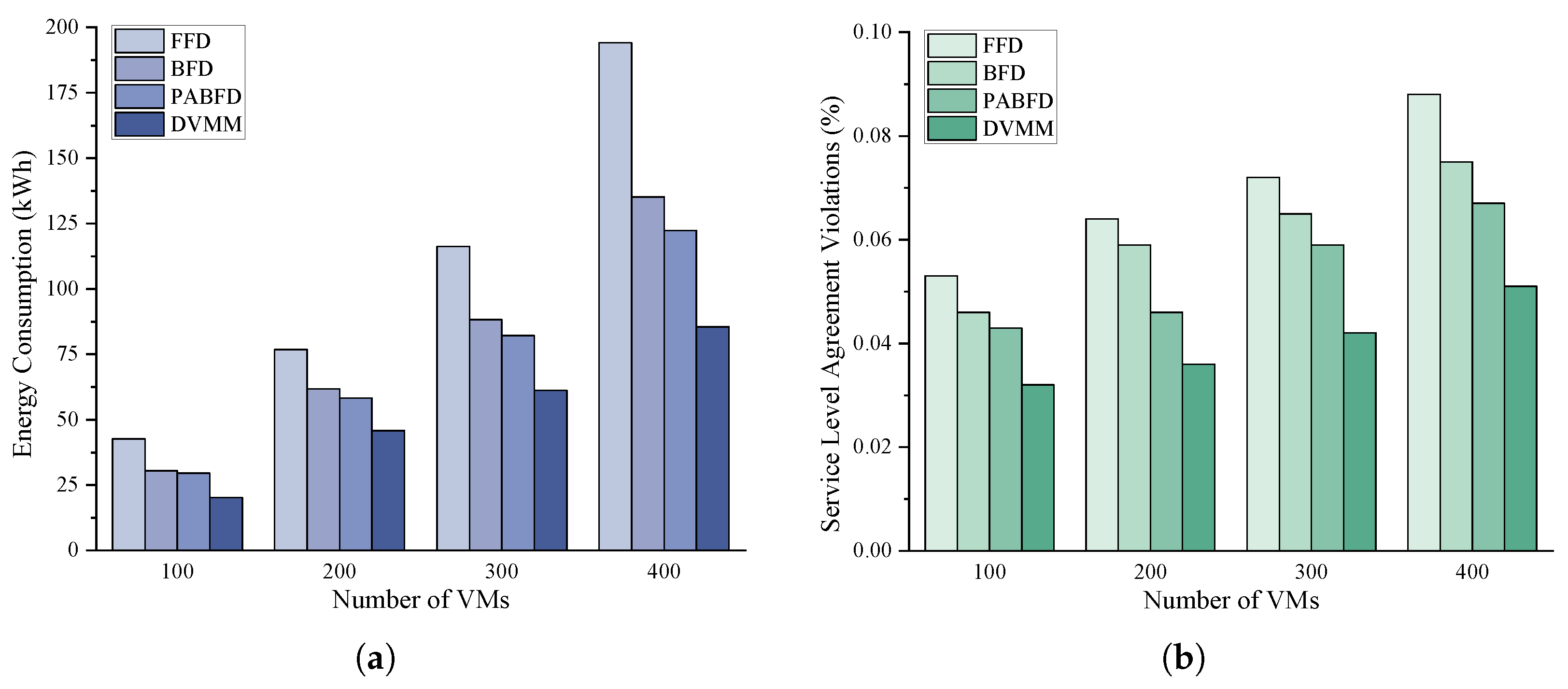EVMC: An Energy-Efficient Virtual Machine Consolidation Approach Based on Deep Q-Networks for Cloud Data Centers
Abstract
1. Introduction
- An energy-efficient VM consolidation method (EVMC) is proposed, aiming to optimize both energy consumption and SLA violation rate in cloud data centers.
- A VM selection strategy based on a co-location coefficient model is proposed. By analyzing the resource utilization correlation among VMs, the strategy evaluates their co-location suitability, thereby identifying the VM least suitable for co-location on an overloaded host. This effectively mitigates resource contention and enhances the accuracy of selection decisions.
- A VM migration algorithm based on deep Q-network (DQN) is proposed, in which VM migration and resource allocation are modeled as a Markov Decision Process (MDP). A composite reward function that considers both energy consumption and SLA violation rate was designed to guide the agent in learning optimal migration and allocation strategies through continuous interaction with the environment.
- Extensive experiments were conducted to evaluate the performance of EVMC. The results demonstrate that the proposed method outperforms existing approaches in terms of energy consumption, SLAV rate, number of migrations, and multidimensional load balancing.
2. Related Work
3. Problem Formulation
3.1. Virtual Machine and Physical Machine Modeling
3.2. Energy Consumption
3.3. Migration Cost
3.4. Service Level Agreement Violation
3.5. Correlation of VM Resource Utilization
4. Proposed Algorithm
4.1. VM Selection
| Algorithm 1 Co-location coefficient-based VM selection |
Input: Overloaded host ;
|
4.2. VM Migration
4.2.1. State Space
- CPU: CPU utilization was an essential element in our study. On the one hand, it was positively correlated with energy consumption. On the other hand, CPU load was closely linked to SLAVs, making it a crucial reference in our research on VM migration.
- RAM: The RAM utilization also affects the duration of VM migration decisions. In addition, there is a significant correlation between RAM utilization and SLAVs, making it an important metric for evaluating service quality.
4.2.2. Action Space
4.2.3. Reward Function
4.2.4. Training Model
| Algorithm 2 DQN-based VM migration |
Input: , Q-network weight , exploration probability
|
4.2.5. Complexity Analysis
5. Performance Evaluation
5.1. Experimental Settings
5.2. Component Validity Analysis
5.2.1. Validation of CVMS
5.2.2. Validation of DVMM
5.3. Comparative Evaluation
5.3.1. Convergence Analysis
5.3.2. Performance Metrics Comparison
5.3.3. Statistical Tests
6. Conclusions
Author Contributions
Funding
Data Availability Statement
Conflicts of Interest
References
- Zhang, P.; Zhang, Y.; Kumar, N.; Hsu, C.H. Deep reinforcement learning algorithm for latency-oriented IIoT resource orchestration. IEEE Internet Things J. 2022, 10, 7153–7163. [Google Scholar] [CrossRef]
- Zhang, P.; Chen, N.; Xu, G.; Kumar, N.; Barnawi, A.; Guizani, M.; Duan, Y.; Yu, K. Multi-target-aware dynamic resource scheduling for cloud-fog-edge multi-tier computing network. IEEE Trans. Intell. Transp. Syst. 2023, 25, 3885–3897. [Google Scholar] [CrossRef]
- Gudkov, A.; Popov, P.; Romanov, S. BalCon—Resource balancing algorithm for VM consolidation. Future Gener. Comput. Syst. 2023, 147, 265–274. [Google Scholar] [CrossRef]
- Patel, P.; Ranabahu, A.H.; Sheth, A.P. Service Level Agreement in Cloud Computing; Wright State University: Dayton, OH, USA, 2009. [Google Scholar]
- Javadi, S.A.; Suresh, A.; Wajahat, M.; Gandhi, A. Scavenger: A black-box batch workload resource manager for improving utilization in cloud environments. In Proceedings of the ACM Symposium on Cloud Computing, Santa Cruz, CA, USA, 20–23 November 2019; pp. 272–285. [Google Scholar]
- Radi, M.; Alwan, A.A.; Gulzar, Y. Genetic-based virtual machines consolidation strategy with efficient energy consumption in cloud environment. IEEE Access 2023, 11, 48022–48032. [Google Scholar] [CrossRef]
- Cortez, E.; Bonde, A.; Muzio, A.; Russinovich, M.; Fontoura, M.; Bianchini, R. Resource central: Understanding and predicting workloads for improved resource management in large cloud platforms. In Proceedings of the P26th Symposium on Operating Systems Principles, Shanghai, China, 28–31 October 2017; pp. 153–167. [Google Scholar]
- Alshammari, M.M.; Alwan, A.A.; Nordin, A.; Abualkishik, A.Z. Data backup and recovery with a minimum replica plan in a multi-cloud environment. In Research Anthology on Privatizing and Securing Data; IGI Global: Hershey, PA, USA, 2021; pp. 794–814. [Google Scholar]
- Avgerinou, M.; Bertoldi, P.; Castellazzi, L. Trends in data centre energy consumption under the european code of conduct for data centre energy efficiency. Energies 2017, 10, 1470. [Google Scholar] [CrossRef]
- Wang, J.; Gu, H.; Yu, J.; Song, Y.; He, X.; Song, Y. Research on virtual machine consolidation strategy based on combined prediction and energy-aware in cloud computing platform. J. Cloud Comput. 2022, 11, 50. [Google Scholar] [CrossRef]
- Imran, M.; Ibrahim, M.; Din, M.S.U.; Rehman, M.A.U.; Kim, B.S. Live virtual machine migration: A survey, research challenges, and future directions. Comput. Electr. Eng. 2022, 103, 108297. [Google Scholar] [CrossRef]
- Li, Z.; Yu, X.; Yu, L.; Guo, S.; Chang, V. Energy-efficient and quality-aware VM consolidation method. Future Gener. Comput. Syst. 2020, 102, 789–809. [Google Scholar] [CrossRef]
- Pourghebleh, B.; Aghaei Anvigh, A.; Ramtin, A.R.; Mohammadi, B. The importance of nature-inspired meta-heuristic algorithms for solving virtual machine consolidation problem in cloud environments. Clust. Comput. 2021, 24, 2673–2696. [Google Scholar] [CrossRef]
- Yao, W.; Wang, Z.; Hou, Y.; Zhu, X.; Li, X.; Xia, Y. An energy-efficient load balance strategy based on virtual machine consolidation in cloud environment. Future Gener. Comput. Syst. 2023, 146, 222–233. [Google Scholar] [CrossRef]
- Tlili, T.; Krichen, S. Best Fit Decreasing Algorithm for Virtual Machine Placement Modeled as a Bin Packing Problem. In Proceedings of the 2023 9th International Conference on Control, Decision and Information Technologies (CoDIT), Rome, Italy, 3–6 July 2023; pp. 1261–1266. [Google Scholar]
- Zhao, C.; Liu, J. A virtual machine dynamic consolidation algorithm based dynamic complementation and ffd algorithm. In Proceedings of the 2015 Fifth International Conference on Communication Systems and Network Technologies, Gwalior, India, 4–6 April 2015; pp. 333–338. [Google Scholar]
- Tandon, A.; Manju, K.; Patel, S. A New VMP Approach Based on CPU and Memory Using Bin Packing. In Proceedings of the 2024 IEEE Pune Section International Conference (PuneCon), Pune, India, 13–15 December 2024; pp. 1–6. [Google Scholar]
- Sayadnavard, M.H.; Haghighat, A.T.; Rahmani, A.M. A multi-objective approach for energy-efficient and reliable dynamic VM consolidation in cloud data centers. Eng. Sci. Technol. Int. J. 2022, 26, 100995. [Google Scholar] [CrossRef]
- Saxena, D.; Gupta, I.; Kumar, J.; Singh, A.K.; Wen, X. A secure and multiobjective virtual machine placement framework for cloud data center. IEEE Syst. J. 2021, 16, 3163–3174. [Google Scholar] [CrossRef]
- Hariharan, B.; Siva, R.; Kaliraj, S.; Prakash, P.S. ABSO: An energy-efficient multi-objective VM consolidation using adaptive beetle swarm optimization on cloud environment. J. Ambient. Intell. Humaniz. Comput. 2023, 14, 2185–2197. [Google Scholar] [CrossRef]
- Singh, S.; Kumar, R.; Singh, D. An empirical investigation of task scheduling and VM consolidation schemes in cloud environment. Comput. Sci. Rev. 2023, 50, 100583. [Google Scholar] [CrossRef]
- Shaw, R.; Howley, E.; Barrett, E. Applying reinforcement learning towards automating energy efficient virtual machine consolidation in cloud data centers. Inf. Syst. 2022, 107, 101722. [Google Scholar] [CrossRef]
- Haghshenas, K.; Pahlevan, A.; Zapater, M.; Mohammadi, S.; Atienza, D. Magnetic: Multi-agent machine learning-based approach for energy efficient dynamic consolidation in data centers. IEEE Trans. Serv. Comput. 2019, 15, 30–44. [Google Scholar] [CrossRef]
- Basu, D.; Wang, X.; Hong, Y.; Chen, H.; Bressan, S. Learn-as-you-go with megh: Efficient live migration of virtual machines. IEEE Trans. Parallel Distrib. Syst. 2019, 30, 1786–1801. [Google Scholar] [CrossRef]
- Caviglione, L.; Gaggero, M.; Paolucci, M.; Ronco, R. Deep reinforcement learning for multi-objective placement of virtual machines in cloud datacenters. Soft Comput. 2021, 25, 12569–12588. [Google Scholar] [CrossRef]
- Tong, Z.; Wang, J.; Wang, Y.; Liu, B.; Li, Q. Energy and performance-efficient dynamic consolidate VMs using deep-Q neural network. IEEE Trans. Ind. Inform. 2023, 19, 11030–11040. [Google Scholar] [CrossRef]
- Zeng, J.; Ding, D.; Kang, K.; Xie, H.; Yin, Q. Adaptive DRL-based virtual machine consolidation in energy-efficient cloud data center. IEEE Trans. Parallel Distrib. Syst. 2022, 33, 2991–3002. [Google Scholar] [CrossRef]
- Beloglazov, A.; Buyya, R. Optimal online deterministic algorithms and adaptive heuristics for energy and performance efficient dynamic consolidation of virtual machines in cloud data centers. Concurr. Comput. Pract. Exp. 2012, 24, 1397–1420. [Google Scholar] [CrossRef]
- Calheiros, R.N.; Ranjan, R.; Beloglazov, A.; De Rose, C.A.; Buyya, R. CloudSim: A toolkit for modeling and simulation of cloud computing environments and evaluation of resource provisioning algorithms. Software Pract. Exp. 2011, 41, 23–50. [Google Scholar] [CrossRef]
- Lange, K.D. Identifying shades of green: The SPECpower benchmarks. Computer 2009, 42, 95–97. [Google Scholar] [CrossRef]
- Panesar, G.S.; Chadha, R. DDPG: Cloud Data Centre Hybrid Optimisation for Virtual Machine Migration and Job Scheduling. In Proceedings of the 2023 3rd International Conference on Technological Advancements in Computational Sciences (ICTACS), Tashkent, Uzbekistan, 1–3 November 2023; pp. 150–156. [Google Scholar]
- Wei, P.; Zeng, Y.; Yan, B.; Zhou, J.; Nikougoftar, E. VMP-A3C: Virtual machines placement in cloud computing based on asynchronous advantage actor-critic algorithm. J. King Saud Univ. Comput. Inf. Sci. 2023, 35, 101549. [Google Scholar] [CrossRef]






| Category | Representative | Strategy | Distinction of EVMC |
|---|---|---|---|
| Heuristic | BFD [15] | Greedy strategy | Co-location coefficient-based VM selection avoiding local optimization |
| FFD [16] | |||
| Meta-heuristic | MOABC [18] | Evolutionary search-based migration | Two-stage integration reducing redundant migrations and accelerating convergence |
| SMVMP [19] | |||
| ABSO [20] | |||
| ML | RL [22] | Migration decisions based on learning mechanisms | Fewer feature dependencies and lightw-eight training |
| MAGNETIC [23] | |||
| MEGH [24] | |||
| DRL | DRLVMP [25] | Neural network policy and adaptive migration | Guided by co-location coefficient for faster convergence and lower overhead |
| DQNVMC [26] | |||
| ADVMC [27] | |||
| EVMC | – | Co-location coefficient-based selection and DQN-based migration | Joint optimization of energy and SLA with fewer migrations and superior energy performance trade-off |
| Category | Type | MIPS | Core | RAM (GB) |
|---|---|---|---|---|
| Host | HP ProLiant G4 | 1860 | 2 | 4 |
| HP ProLiant G5 | 2660 | 2 | 4 | |
| VM | Micro instance | 500 | 1 | 0.85 |
| Small instance | 1000 | 1 | 1.70 | |
| Extra-large instance | 2000 | 1 | 3.75 | |
| High-CPU medium instance | 2500 | 1 | 0.85 |
| Host | 0 | 10 | 20 | 30 | 40 | 50 | 60 | 70 | 80 | 90 | 100 |
|---|---|---|---|---|---|---|---|---|---|---|---|
| HP ProLiant G4 | 86 | 89.4 | 92.6 | 96 | 99.5 | 102 | 106 | 108 | 112 | 114 | 117 |
| HP ProLiant G5 | 93.7 | 97 | 101 | 105 | 110 | 116 | 121 | 125 | 129 | 133 | 135 |
| Metrics | SMVMP | MEGH | DVMP | AVMP | EVMC | |||||
|---|---|---|---|---|---|---|---|---|---|---|
| V | R | V | R | V | R | V | R | V | R | |
| Energy | 5 | 4 | 2 | 3 | 1 | |||||
| SLAVs | 4 | 5 | 2 | 3 | 1 | |||||
| MigNum | 5 | 4 | 3 | 2 | 1 | |||||
| MLB | 5 | 4 | 2 | 3 | 1 | |||||
| Rank | 4.75 | 4.25 | 2.25 | 2.75 | 1.00 | |||||
Disclaimer/Publisher’s Note: The statements, opinions and data contained in all publications are solely those of the individual author(s) and contributor(s) and not of MDPI and/or the editor(s). MDPI and/or the editor(s) disclaim responsibility for any injury to people or property resulting from any ideas, methods, instructions or products referred to in the content. |
© 2025 by the authors. Licensee MDPI, Basel, Switzerland. This article is an open access article distributed under the terms and conditions of the Creative Commons Attribution (CC BY) license (https://creativecommons.org/licenses/by/4.0/).
Share and Cite
Zhang, P.; Gao, J.; Liu, J.; Tan, L. EVMC: An Energy-Efficient Virtual Machine Consolidation Approach Based on Deep Q-Networks for Cloud Data Centers. Electronics 2025, 14, 3813. https://doi.org/10.3390/electronics14193813
Zhang P, Gao J, Liu J, Tan L. EVMC: An Energy-Efficient Virtual Machine Consolidation Approach Based on Deep Q-Networks for Cloud Data Centers. Electronics. 2025; 14(19):3813. https://doi.org/10.3390/electronics14193813
Chicago/Turabian StyleZhang, Peiying, Jingfei Gao, Jing Liu, and Lizhuang Tan. 2025. "EVMC: An Energy-Efficient Virtual Machine Consolidation Approach Based on Deep Q-Networks for Cloud Data Centers" Electronics 14, no. 19: 3813. https://doi.org/10.3390/electronics14193813
APA StyleZhang, P., Gao, J., Liu, J., & Tan, L. (2025). EVMC: An Energy-Efficient Virtual Machine Consolidation Approach Based on Deep Q-Networks for Cloud Data Centers. Electronics, 14(19), 3813. https://doi.org/10.3390/electronics14193813








